An evaluation of the Yorkshire Sustainable Landscapes programme: Farmers’ perceptions and behaviour
By Shervin Shahvi, Julia Martin-Ortega and Pippa Chapman
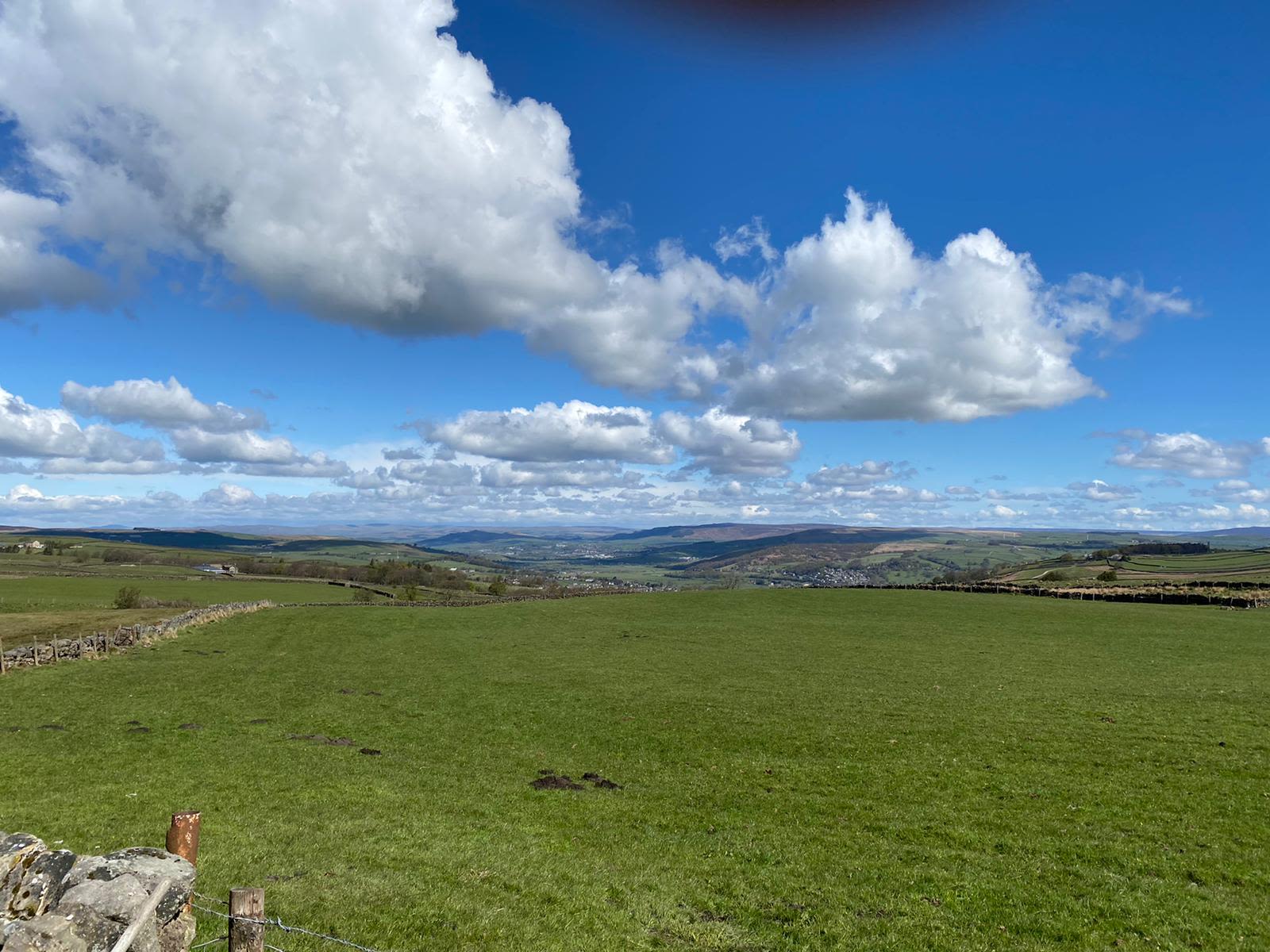
1. Introduction
Diffuse pollution from agriculture remains one of today’s major challenges at the intersection between food security and environmental protection. In recent years there has been a concerted effort to influence farmers’ behaviour to adopt best management practices (BMPs) in order to tackle diffuse pollution from agriculture. One of the strategies to induce behavioural change is that of raising land manager’s awareness of the environmental effects of farming practices and mitigation measures. Improving farmers’ awareness is expected to deepen their understanding of the link between land management practices and diffuse water pollution, with the expectation that this will in turn motivate a change in behaviour that increases uptake of BMPs. There is now an emerging body of literature that supports this link (although it is also acknowledged that is complex and is affected by multiple factors).
This awareness-based approach to mitigating diffuse pollution is increasingly being promoted and implemented at the policy level, but we also see an increased number of public and/or private partnerships, often involving water utilities in association with land managers and other stakeholders. One such initiative is the Sustainable Landscapes Programme (SLP) in Yorkshire, UK. The SLP, launched in 2018 and resulting from the partnership between the water utility Yorkshire Water and the firm Future Food Solutions, who are a firm of supply chain specialists operating across the UK. The initiative aims to improve water quality by reducing the volume of soil erosion and the amount of nutrients and pesticides leaching from agricultural land into water bodies. It does so by bringing farmers together to explore sustainable land management methodology and to share best practice.
The SLP is perceived by its promotors to have been successful in its aims of bringing farmers together and engaging in a dialogue with them on sustainable management practices. The aim of this study is to evaluate the programme from the perspective of the participating farmers. It focusses on determining the farmer’s perceptions of the programme and identifying signs of behavioural change, associated with increased awareness resulting from their engagement in this voluntary programme (why did they engage and stay engaged with the programme, what did they gain from the programme and what agricultural practices did they change and why).
The research is based on semi-structured interviews with the programme promoters and 11 participating farmers across the three pilot area covered by the programme. The interviews took place during spring/summer of 2021, ie three years into the SLP.
2. The Sustainable Landscape Programme

The Sustainable Landscapes Programme (SLP) was designed and delivered by Future Food Solutions and was sponsored by Yorkshire Water. It evolved out of the Sustainable Futures Programme which had been running for three years prior to the start of the SLP. Yorkshire Water’s initial aim with the Sustainable Landscapes Programme was to engage more collaboratively with farmers in their area of operation and establish an improved partnership with the farming community to tackle some of the key issues affecting water quality.
The SLP was launched in July 2018, bringing together groups of farmers to explore sustainable farming practices, with the aim of positively impacting soil health and improving water quality in the region. The programme sought to achieve this by encouraging farmers to: 1) measure soil quality by improving access to novel technology; 2) manage farm resources more efficiently; and 3) collaborate and exchange knowledge with other farmers, Yorkshire Water and supply chain partners.
The SLP worked closely with farmers implementing a series of engagement activities and soil health tools. Farmers were provided advice in a number of areas, including how to increase soil organic matter based on soil type and cropping history. The programme promoted and supported the use of cover crops (by initially paying for the cover crop seeds) and it highlighted the benefits of direct drilling and precision farming techniques. The programme also encouraged the uptake of new ways to control weeds and pests, such as slugs. One area of focus of the programme in the longer term is to replace the use of Metaldehyde pellets as a method of slug control.
The SLP also connected farmers with soil scientists and service providers that could help them determine soil quality more accurately (such as a company offering comprehensive precision farming service and a company providing farm management software). Farmers were also shown how to manage crop inputs more precisely in order to maximise their yields and to reduce nutrient leaching.
The SLP also included a Travel to Learn (TTL) programme involving visits overseas. The TLT concept was inspired on previous experiences that indicated that farmers made positive cultivation changes to their own farm practices when they saw a technique being successfully deployed on land similar to their own. Farmers from the SLP attended overseas visits to Holland, Belgium, France and the USA. There have also been TTL visits to see examples of best practice in the UK.
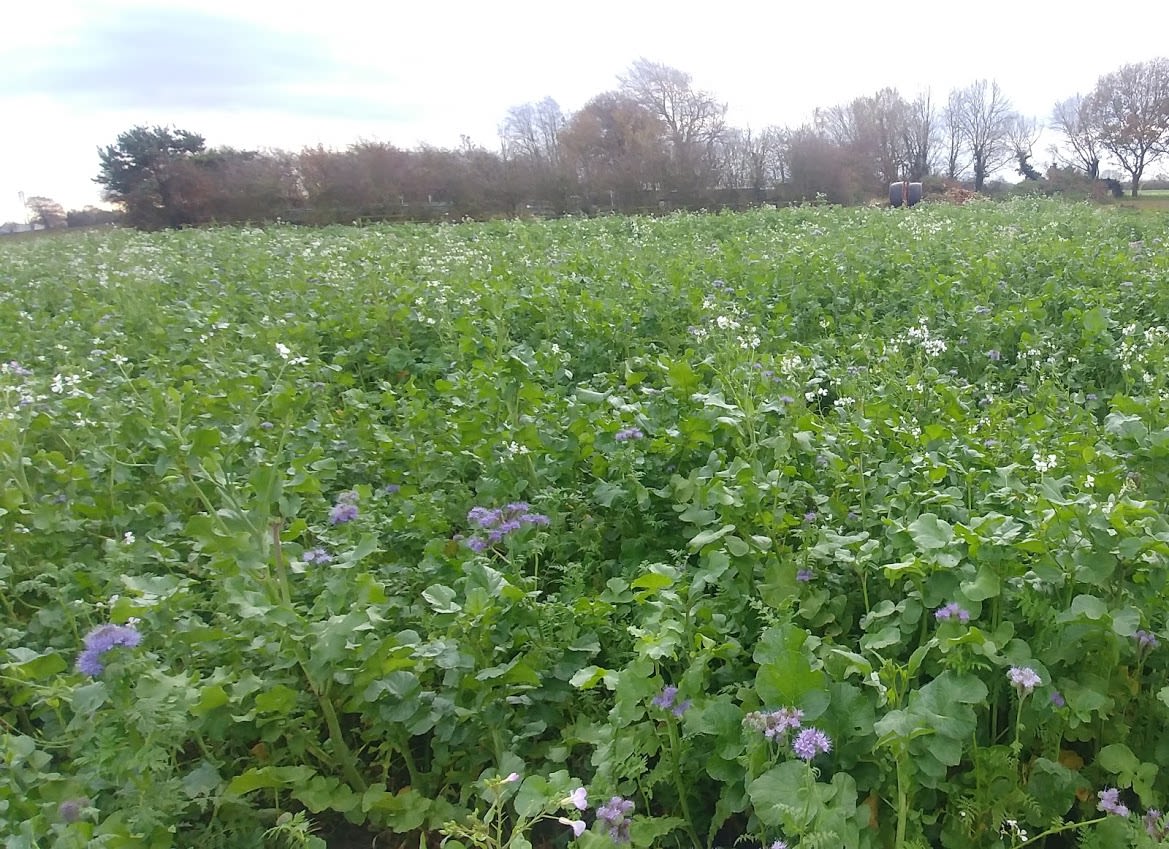
Cover crops. Photograph by Future Food Solutions
Cover crops. Photograph by Future Food Solutions
Resources available to farmers within the pilot areas are:
- Sustainability benchmarking
- Soil analysis and testing
- Soil organic matter level testing
- Provision of Cover crop advice
- Provision of Cover crop seed to farmers within the pilot
- Option to change from on farm metaldehyde use to Ferric Phosphate where appropriate
- GPS driven soil quality management
- Gatekeeper – software and training from Farm Plan
The programme focused on how adoption of these various practices, techniques and services could benefit the farm business (profitability and resilience), but also how it could improve the environment by reducing the use of chemicals and ensuring that nutrients and pesticides that were used stayed on the field rather than reaching adjacent waterways.
The SLP initially operated in three main pilot areas within Yorkshire (see Figure 1) and has engaged with over 200 farmers in the last three years:
- Topcliffe: Located 5 miles to the southwest of Thirsk and adjacent to the River Swale, the Topcliffe Pilot Area is within the River Swale catchment area which feeds into River Ouse and enters the North Sea via the Humber estuary. The pilot area has 19 farmer members, most of whom are undertaking arable farming activities.
- Shipton by Beningbrough: The Shipton by Beningbrough Pilot is located to the North West of York and geographically, the Pilot Area is located close to the River Ouse. The land tends to be slightly heavier than farmers experience at the Topcliffe pilot further north, however similar crop rotations are undertaken. The Pilot Area has a wide-ranging membership of 16 farming individuals with some members undertaking beef and pig operations, with knowledge alongside arable specialists.
- Elvington: The Elvington Pilot Area is centred at Grimston Grange in Heslington and situated to the south east of York. The Pilot Farms are located between the River Ouse to the west and the River Derwent to the East. The area is within a zone of particular importance in terms of regarding surface water management. Yorkshire Water have treatment facilities four miles away at Elvington where they extract water from the River Derwent prior to treatment and distribution elsewhere in Yorkshire. The Pilot Area has 18 members, all of them farm in the surrounding area with potatoes, carrots and other root crops included in their arable rotation.
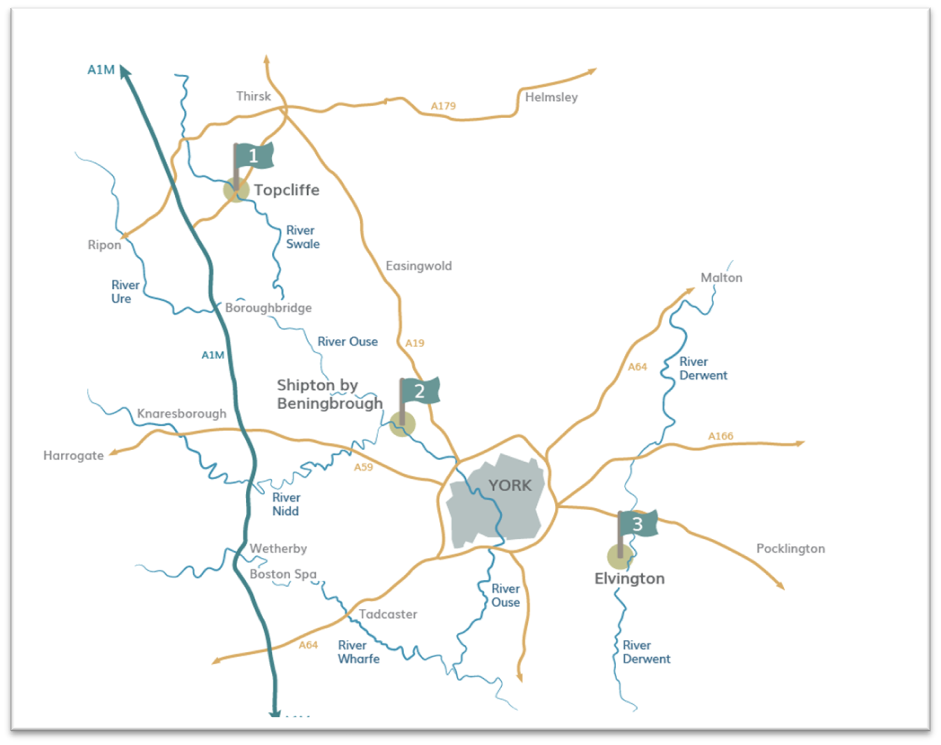
Figure 1. Pilot areas in the Sustainable Landscape Program
Source: Sustainable Landscape Program Website, Accessed: August 2021.
3. The Method

A qualitative approach using semi-structure interviews was used. The interviews were carried out in two phases. Phase one included framing interviews with three key informants, corresponding to the promoters and implementers of the programme, ie a representative of Yorkshire Water (respondent 1) and the two directors of the Future Food Solutions firm (respondents 2, 3). Yorkshire Waters’ representative is the company’s expert on Upland and Lowland catchment management. The two Future Food Solutions are food and drink supply chain professionals with experience in the farming sector. The aim of this first set of interviews was to gain an understanding of the programme and to determine the topics to cover in the farmers’ interviews. The second phase included interviews with volunteer farmers involved in the program.
Potential interviewees were contacted by Future Food Solutions and the contact details of those who agreed to be interviewed were passed to the research team. This means that the recruitment of participants was enabled by one of the programme promoters. It is possible that this may have introduced some bias in the sampling process (this is: by contacting farmers who were anticipated to have positive views on the SLP). Furthermore, participation in the SLP is entirely voluntary (and did not include any kind of direct incentive, for example in the form of payment, to participate). This means that there is a natural self-selection in that it would have attracted farmers that have a general predisposition for engagement in discussions for improving land management practices, as well as innovation-prone farmers. This is not considered to be problematic for this study, since its aim is not to provide an evaluation of a fully representative sample of all farmers in the region, but to understand the motivations, perceptions and potential behavioural changes of those positively engaged in the SLP. This is: we want to understand why it worked for those for whom it did work. Still, as it will be seen in the results section, there were some critical voices with the programme too.
The research team were provided with contact details of 15 farmers. All 15 farmers were contacted by phone by the research team who briefly explained the aim of the study and the methods that would be used. From the initial 15 farmers, eleven interviews were finally conducted. Eight of the interviews were conducted via online video-conference and were video recorded. Three of the interviews were conducted by phone calls and were audio recorded. All video and audio records were transcribed.
A brief background on the characteristics of the interviewed farmers is presented in Table 1.
Table 1. The characteristics of the interviewed farmers
Interviewee and Characterisation
Farmer 1 Male, 62, arable farm, owned farm (284 ha), other sources of income
Farmer 2 Male, 40s, arable farm, owned farm (165 ha), income from farming only
Farmer 3 Male, 28, arable and livestock farm, owned farms (162 ha), income from farming only
Farmer 4 Male, 50s, arable farm, owned and rented farms (175 ha), income from farming only
Farmer 5 Male, 53, arable farm, owned farm (230 ha), other sources of income
Farmer 6 Male, 40s, arable, owned farm (115 ha), income from farming only
Farmer 7 Female, 50s, arable and livestock farm, owned and rented farm (400 ha), income from farming only
Farmer 8 Male, 40s, arable and livestock farm, owned farm (120 ha), income from farming only
Farmer 9 Male, age not mentioned, arable farm, owned farm (265 ha), 95% of total income from farming
Farmer 10 Male, age not mentioned, arable farm, rented farm (500ha), other sources of income
Farmer 11 Male, 50s, arable farm, rented farm (223 ha), income from farming only

Flowering Silitina radish. Photograph by Future Food Solutions.
Flowering Silitina radish. Photograph by Future Food Solutions.
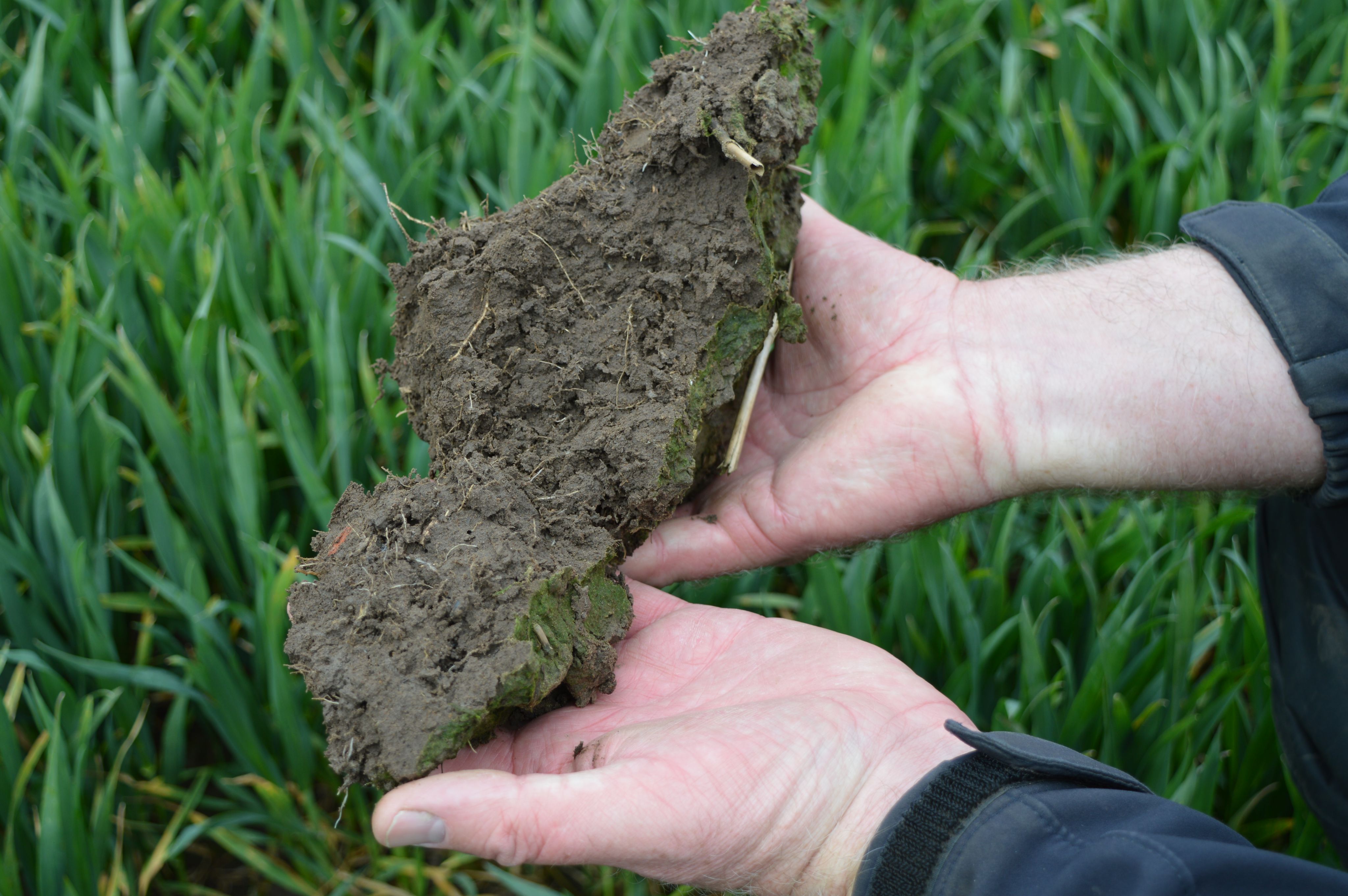
Soil structure beneath wheat post cover crops. Photograph by Future Food Solutions
Soil structure beneath wheat post cover crops. Photograph by Future Food Solutions
The script for the farmers’ interviews was designed after carrying out the framing interviews with the key developers of the SLP. The interview started with a brief introduction to the research team and the aim of the study.
The interviews contained two main parts: the main questions and the profiling questions. The main questions started with general questions regarding the SLP and the participants’ understandings of its aim, as well questions about their motivations for participating in it. Participants were then asked about the main initiatives of the programme and their understanding of and engagement in them. In the next series of questions, interviewees were asked if they had changed any of their farming practices/behaviours as a result of being involved in the SLP, and if yes in what way. Subsequently, interviewees were asked what they thought were the main reasons for why farmers (themselves and other participants) changed their behaviour/practices.
Although they had the freedom to answer this question with their own examples/options in mind, the interviewer was especially interested in factors such as experiential learning, peer-learning and social effects. The academic literature has shown how these factors influence the link between awareness raising and behavioural change for the adoption of best land management practices. Prompts regarding these factors were therefore introduced in the interview process. In the final set of questions, participants were asked about their views on Yorkshire Water, the programmes facilitators and advisors and the benefits they obtained from participating in the SLP.
The profiling questions referred to farm characteristics, such as farm type, size and category, and farmers’ socio-demographic information, such as gender, age and sources of income.
Data from the interviews were analysed using qualitative thematic analysis. This was done by carefully reading through the interview transcripts and identifying recurring topics that emerged from the text rather than on the basis of pre-defined topics. We identified statements that provided plausible explanations to the topics under consideration.
4. The Results
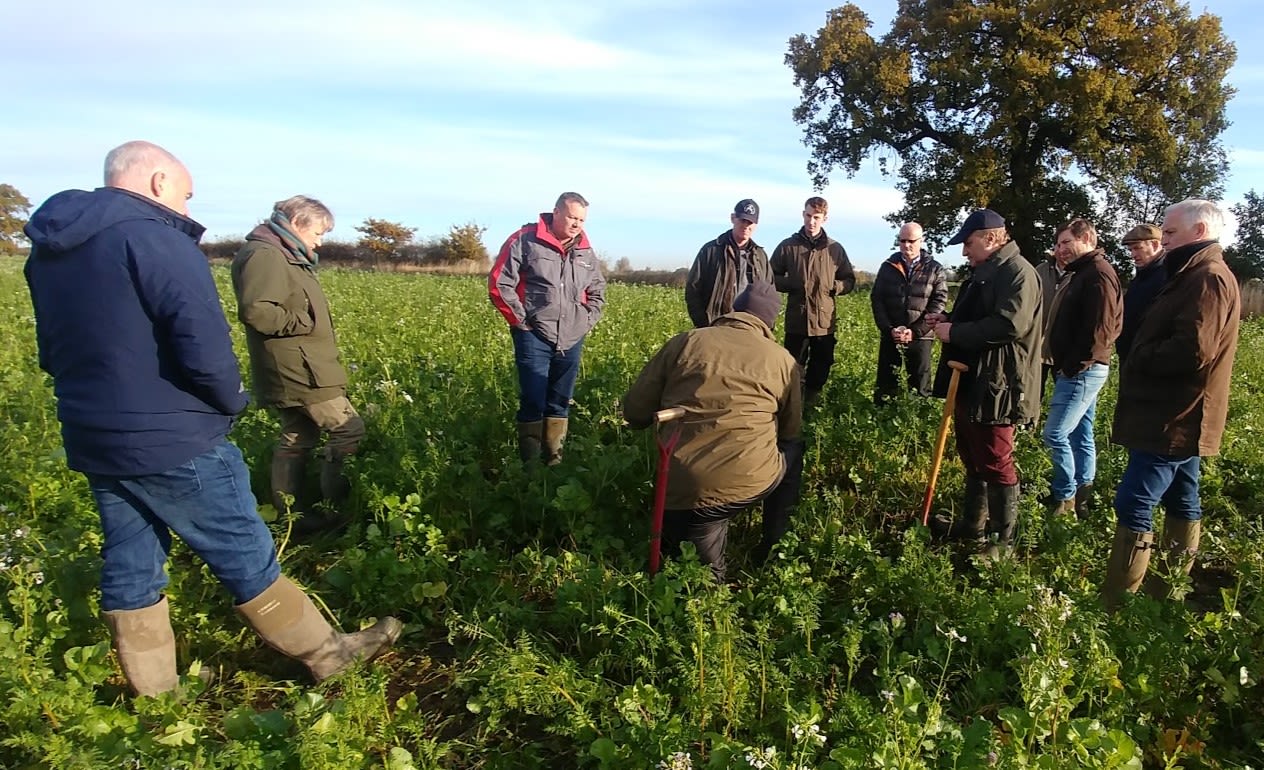
4.1. Framing interviews with key informants
Interviews with the key informants outlined that the main aims of the SLP were to improve soil and water quality, increase famers’ engagement and to increase both farm productivity and profitability. They believe that the main motivation for farmers to participate in the program was to solve farming problems, ie “to be more profitable, more resilient and to improve water quality’’ (respondent 1).
The key informants explained that the ‘good soil guide’ and the ‘sustainability index’ were designed mainly to achieve environmental improvements and to assess the five key areas of water, soil, biodiversity, and community and carbon footprint. They believe that this type of knowledge can be transferred mainly by peer-learning and the visit to overseas farms.
The SLP promotors got an 80% positive feedback from farmers regarding these sub-programs in an internal survey carried out after the overseas visits.
Regarding changes in farmers’ behaviour, the key informants reported that farmers made changes in their agricultural practices when they could see the benefits to their farms (particularly in terms of profitability). From the key informants perspective, experiential learning was a very important factor in this regard, as they always “ask people to do things at their own pace, encourage farmers to see what their neighbour is doing and share their experience’’ (respondents 2,3). In general, they considered that farmers who adopted BMP on their own farm could then see the outcome with their own eyes and learn from doing and share their experiences.
Another important factor in the SLP, according to the key informants, was the development of trust with the farmers as shown by this response: “we never push them about what they should do. Farmers in Yorkshire are very independent and strong minded so we only presented things as possibilities’’ (respondents 2, 3). Social encouragement was another factor mentioned in this regard as enhancing farmers’ motivation. Financial and non-financial constrictions (lack of time, trust, lack of training) were seen as barriers to achieving the programme’s goals.
Answering the question about ‘what the organisers of the SLP believed to be the key benefits of programme for the farmers’, they mentioned economic (profitability, decreased dependency on the government) and non-economic (gained knowledge and deeper understanding of soil, efficiency) benefits for farmers and the environment.
The informants also believed that changes to agricultural subsidies as a result of Brexit and the new agricultural bill will mean that farmers will have to modify their farming practice and that the SLP could help farmers adopt to those changes very quickly.
The key informants regarded their role as a ‘facilitator’ as very important for the SLP and for motivating farmers to sustain the benefits of the programme: “they made step changes in their farming and that innovation would remain’’, “Farmers are now more aware of the influence of their activities on water and water quality” (informants 2 and 3).
The last question explored how the key informants believed the farmers view of their organisation (ie that of the promoters of the SLP) had changed as a result of participating in it. They believed that the SLP in general has helped improving this, “they were initially a little bit worried and suspicious of Yorkshire Water (in the beginning) but now this view has changed, and they see Yorkshire Water as a partner’’, (respondents 2 and 3).
In summary, promoters of the SLP seem to have a very positive view of how farmers perceived it. In the next section, we explore this with the farmers themselves.
4.2. Farmers interviews
Results of the analysis of the interview with farmers are organised in a series of overarching themes, which are presented together with statements illustrating the main arguments within the themes.
Motivations for participating in the SLP and what farmers hoped to achieve
The main reasons mentioned by farmers regarding their motivation for participating in the SLP and what they had hoped to achieve are focussed around the following factors: learning new things, reducing the impact of farming on the environment and financial savings. This is illustrated by the following examples of statements made by the farmers:
“I expected to be able to learn from experts but more from other farmers so then I can have new ideas, which I can implement on my own farms.’’ (Farmer 1)
“We use different methods and so we would not damage the earth possibly and protect environment and water courses. We expect to achieve different sides of knowledge, learn different things and progress because things are changing faster than before.’’ (Farmer 3)
“It’s aims are to improve the local environment through our actions which will help companies, such as Yorkshire Water, with their environmental concerns and hopefully working in partnership will result in benefit both for us and them [Yorkshire Water] in terms of reducing our carbon footprint and reducing Yorkshire Water’s costs in terms of those associated with removing nitrate and chemicals from the water.’’ (Farmer 2)
“In our business we need to reduce labour costs and one way to do this is to adopt new techniques/technologies that allows us to run the farm with one person instead of two.’’ (Farmer 4)
“I am always looking to learn, looking for best practice, for increased profitability and less impact on the environment and do better farming for each of them.’’ (Farmer 5)

Soil beneath crop post cover crop. Photograph by Future Food Solutions.
Soil beneath crop post cover crop. Photograph by Future Food Solutions.

Regenerative Agriculture in practice Sheep grazing on cover crops Topcliffe. Photograph by Future Food Solutions.
Regenerative Agriculture in practice Sheep grazing on cover crops Topcliffe. Photograph by Future Food Solutions.
Farmers views on the good soil guide and sustainability index
Only a few farmers have applied both the advice in the good soil guide and the sustainability index on their farms. The farmers said they had attended the related meetings about them but were not applying them or that they already had similar measures in place and so did not see the benefit of replacing them with these new ones. Examples of quotes that illustrate this include:
“We do our own soil and nutrient monitoring anyway so we always do that so that was not a new thing to me.’’ (Farmer 10)
“I have not applied any of those. I tested my soil with other methods.” (Farmer 2)
“I have not used the good soil guide. I have done the sustainability index but have not been involved in subsequent monitoring.” (Farmer 8)
However, questions around the Good Soil Guide and the Sustainability Index did show a general understanding of the need to preserve healthy soil, as revealed for example by this quote from Farmer 1: “The Good soil guide is about improving soil health, for example by not cultivating or disturbing it and if I don’t disturb the soil, I don’t disturb the soil life indeed and that is a part of sustainability as well”. It does not seem, though, that the specific tools presented by the SLP are the most valued by the farmers, as expressed in this quote: “Sustainability index is trying to measure how sustainable we are farming and that is looking at our attitude (cover crops, how much fertilizer we use). Personally, I am less interested in that, and I am more interested in what little steps I am making to improve the farm rather than been liable to an index’.’ (Farmer 11)
Has participation in the SLP changed farmers views?
The main themes extracted from the farmers interviews regarding how their views have changed as a result of participating in the SLP relate to continued learning, improved practices and environmental improvement. Some farmers felt they already had relevant knowledge on the areas covered by the SLP. This is coherent with the fact that the farmers participating in the SLP are a set of innovative, well-motivated farmers with a likely pre-existing interest in improving land management practices (eg “We were already on this path before participating in the SLP and been aware of what they were doing” Farmer 4). But in general, the participating farmers felt that they have increased their knowledge or filled some knowledge gaps:
“Involvement in this program definitely increased my knowledge. With focus on carbon, it also [resulted in] changes in my farming practices. You always learn in this kind of programme and one good thing is to learn from each other. I would not say there was anything which was contradicted but there was clear gap in my knowledge which have been filled so I could see where those gaps are, and I could fill them.” (Farmer 5).
Some even identified some contradictions between their previous knowledge and what they have learnt through the programme, as shown by these quotes:
“We learnt a little is better than a lot, do less and get more out of it because you save money, save the environment and water courses. We definitely improved. Contradiction was regarding the use of power harrow that we used to do it a lot before but now we don’t do it anymore.’’ (Farmer 3).
“Contradiction happened, eg cultivation in general, after talking with advisors I do it entirely differently [now].’’ (Farmer 1)

Topcliffe group meeting. Photograph by Future Food Solutions.
Topcliffe group meeting. Photograph by Future Food Solutions.

Shipton group meeting. Photograph by Future Food Solutions.
Shipton group meeting. Photograph by Future Food Solutions.
Changes in farming practices as a result of involvement in the SLP
Farmers believe that their involvement in the SLP has resulted in some gradual change to their farming practices and that they have benefited from this. Examples include:
“When I first joined, we were not doing any cover cropping and then we did it every year and we see the benefits of cover cropping [….]. We implement the cover cropping and reduce the amount of fertilizer being used. We halted using ploughing last year and we reduced the cultivation and now direct drill for cultivation.’’ (Farmer 10)
“I have a pig unit so I try to use as much pig slurry as possible and I do not use as much nitrogen [fertiliser].’’ (Farmer 7)
“I now certainly use much more cover crops. I certainly don’t use much fertilizer and we don’t put any phosphate. We certainly don’t use vast amount of nitrogen [fertiliser].” (Farmer 1)
“We also completely switched from using Methaldehyde to ferric phosphate [for pest management].” (Farmer 2)
“We [now] have [an] N tester and, this spring, by using it we realized that we were putting] on a lot of nitrogen previously.’’ (Farmer 3)
Reasons why farmers changed their practices
When asked about the reasons behind the adoption of new practices as a result of participating in the SLP, most farmers expressed arguments related to peer-learning and their overseas experience. For example, as stated explicitly by farmer 8: “Peer learning is absolutely important which was visiting other farms, see how other things works and to learn from other farmers and see how things work locally as well as nationally. In general farmers like to hear from other farmers.”
Interaction with advisors and experts was appreciated, but it was the informal interaction with other farmers that provided the key to the learning process, as illustrated by this sequence of quotes:
“Within groups people with required knowledge had told us how to do the things and to get involved. They encouraged us to use carbon capture and cover cropping as a means of boosting farming income and to make good environment and these things takes years for a farm to turns around to be sustainable.” (Farmer 4)
“Peer learning was of much importance because you see things and then you start to do them yourself.” (Farmer 3)
“The meetings and talking to other farmers were very important. Even if it is a meeting about something else, a chat after that to see what other people do and their ideas are very beneficial, experiential learning was definitely an important factor in this program; we had meetings and discussions about cover crops and advisors talked about that, so we came back [home] and started trying it in our own situation.”(Farmer 2)
The overseas experience provided additional evidence to farmers and increased their willingness to try the methods explored in the SLP, as programme, as evidenced in the following quotes:
“Travelling is good to see the problems that exist elsewhere and to see [how] people have dealt with common problems and so traveling is like a cross border peer to peer learning and it is useful and interesting.” (Farmer 5)
“In our trip to US, you usually see people in different environment and climate and the methods work for them and we think although they are not completely changeable but if it works for them can it work for us as well. It makes you think that I’m going [about it] the right way.’’ (Farmer 1)

Soil structure beneath wheat post cover crops. Photograph by Future Food Solutions.
Soil structure beneath wheat post cover crops. Photograph by Future Food Solutions.

Innovation Groups Elvington Pilot meeting. Photograph by Future Food Solutions.
Innovation Groups Elvington Pilot meeting. Photograph by Future Food Solutions.
Other factors motivating change
Farmers believe there are other factors which make them change their behaviour and result in changes to their farming practices. They expressed arguments relating to social responsibility and environmental concern as two important factors in this regard:
“I am aware of social responsibility and as a farmer if I have been beneficiary then I do well and then my neighbours would look and start to be involved and this can then happen in a robust catchment system like we have in Yorkshire.” (Farmer 5)
“We take responsibility for our actions and we should accept changes such as climate change.’’ (Farmer 1)
“More pressure was from the environmental side that we want to preserve our environment, we wanted to look after our soils and to think about future generation regarding this too leave them with the soil that we grow food sustainably on. It was also that we could grow better crops with lower costs in terms of lower chemicals and fertilizers.” (Farmer 2)
The role and importance of facilitators and Yorkshire Water
Farmers gave importance to the role of facilitators in the process:
“Facilitators were very important because they explained how the water got contaminated from what we put in the field and you never think about that or never think about what drained down [sic] to the field and then when they tell you, it makes you to think.” (Farmer 3)
“Facilitators are someone who you need to use the time and someone who can organise the program then you can get the information or the seeds that’s good so and otherwise the farms would not get involved.’’ (Farmer 5).
“The role of facilitators was definitely important. If you get a right [sic] speaker who inspires and has had a good experience then certainly it helps. If they say; this is what I would do then definitely yes, we do as well.” (Farmer 2)
They also show a positive attitude towards Yorkshire Water after three years of being involved in the SLP, recognising an interest to work in partnership with farmers:
“My opinion has changed regarding the role of Yorkshire Water as they want to work in partnership with farmers and they are certainly not saying: you must do this.” (Farmer 2)
“I have been very impressed by the role of Yorkshire Water during the programme. A genuine desire to help farmers move towards sustainable practices. It is a great credit to Yorkshire Water than they have funded the start-up of these groups.’’ (Farmer 1)

Flowering Silitina radish. Photograph by Future Food Solutions.
Flowering Silitina radish. Photograph by Future Food Solutions.

Photograph from the Andrew Walker Summer Collection.
Photograph from the Andrew Walker Summer Collection.
Benefits obtained from participating in the SLP
Most farmers said they had not observed any yield improvement yet as a result of being involved in the SLP. However, they do acknowledge a range of other benefits, in relation to expected profitability, environmental improvement and motivation. They see this as the beginning of a process for improvement on those matters:
“I had a great deal of benefit by participating in the programme because there have been practical discussions on farm about how to improve the soils and moving towards more sustainable farming and I have implemented those ideas to makes more steps going forward. It was more than my expectations but for all the farmers involved there are different stages of sustainable farming and we made small steps in the right direction.’’ (Farmer 11)
“The yields have not increased yet, because it is just the starting point and may be better this summer but definitely yes with profitability because we don’t use contractor to drill now, and we don’t use that much fuel to drill because we don’t do it as much as we did before.” (Farmer 3)
“It certainly did not increase our yields but it gradually lowering our cost which increases profitability. We spend more time on thinking about management of soils and farm than on tractors. We certainly noticed a real change in biodiversity on the farm.” (Farmer 2)
As an example of motivation, farmer 1 indicates “It motivates me to continue in the right direction.”
5. Key Messages

- The SLP aims to improve water quality by reducing the amount of soil erosion and leaching of nutrients and pesticides reaching the waterways. It does so by bringing farmers together to explore sustainable land management practices.
- The SLP is perceived by its promotors to have been successful in its aims of bringing farmers together and engaged in a dialogue on sustainable management practices.
- Results of interviews with participating farmers show how they display positive attitudes towards the SLP and its objectives.
- Motivations for participating in the programme revolve around learning, progressing environmental improvements and financial saving
- The specific Good Soil Guide and the Sustainability index does not seem to have had a particularly relevant impact on influencing farmers attitudes and behaviours, probably because the participating farmers already had some previous experience and a general understanding of the need to preserve good soil conditions and analyse soils for nutrient content.
- Farmers do, however, acknowledge that the SLP has led to continued learning and improved knowledge, improved practices and environmental improvement.
- Farmers believe that their involvement in the SLP has clearly resulted in some gradual change to their farming practices and that they have benefited from this. Peer learning across farmers participating in the programme and through the overseas experience are seen as key to this.
- Interaction with advisors and experts was appreciated, but it was the informal interaction with other farmers that provided the key to the learning process and changes in practices. Other factors included social responsibility and environmental concern.
- Farmers show a positive attitude towards Yorkshire Water after three years of being involved in the program, recognising an interest to work in partnership with farmers.
- While no yield improvement has yet occurred as result of participating in the programme, farmers acknowledge a range of benefits, in relation to expected increased profitability, environmental improvement and their own motivations to do so. They see this as the beginning of a process for improvement.
The above messages need to be contextualised under the backdrop that this is not a representative sample of the general population of farmers in the Yorkshire region, but that a natural self-selection bias would be present, firstly as part of their participation in the SLP to start with (this is a volunteer partnership programme, so participants would have already had a pre-disposition to engage in a discussion with stakeholder about land management practices) and secondly, as a consequence of the interview recruitment process. However, results are in line with previous findings from the literature on that awareness-focused approaches for mitigating diffuse pollution do relate to an improved understanding of the link between farming practices and environmental impacts. It also reinforces finding on the key role that peer learning and demonstrations plays in the changing of attitudes and (gradual) change of farming practices. It also corroborates that, while financial motivations related to profitability and reduced costs are very important, they are not the sole factor for inducing change of farming practices. Trusted facilitators, as well as social motivations, also play a critical role.
As a final recommendation, for changes in farming practices to consolidate in time and expand in scope, it is important that programmes like the SLP are sustained overtime. Farmers’ attitude towards Yorkshire Water’s motivations found in this study are promising, since farmers themselves see this as a first step of something that needs to be continued into the future. That can play a critical role in expanding the more sustainable farming practices to less motivated farmers.
Acknowledgements

This work has been funded by the RePhokus project (The role of phosphorus in the sustainability and resilience of the UK food system) funded by Global Food Security Resilience of the UK Food System Program and the Integrated Catchment Solutions Programme (iCASP) funded by the UK Natural Environment Research Council’s Regional Impact from Science of the Environment scheme. The research has been approved by the Research Ethics Committee of the University of Leeds (REF: LTSEE- 093). We acknowledge the contribution of Steve Cann and Andrew Walker for facilitating the access to farmers. The authors are grateful to the farmers who participated in this research. Thanks also to Ann Marie Boyle water@leeds administrator for report design.


